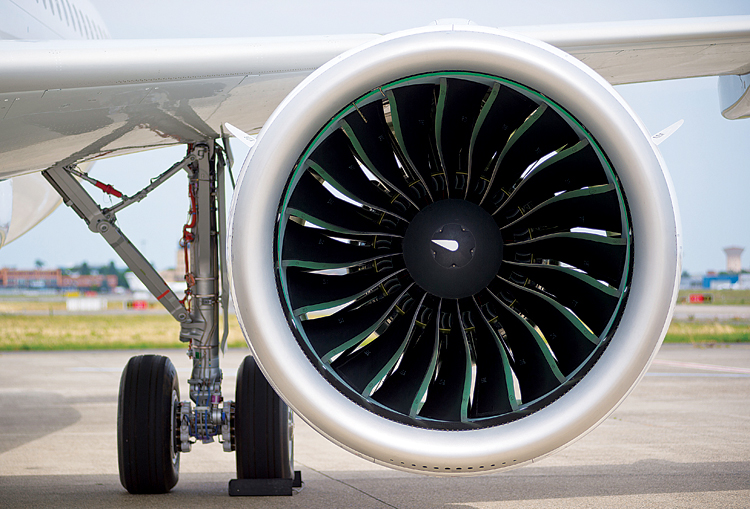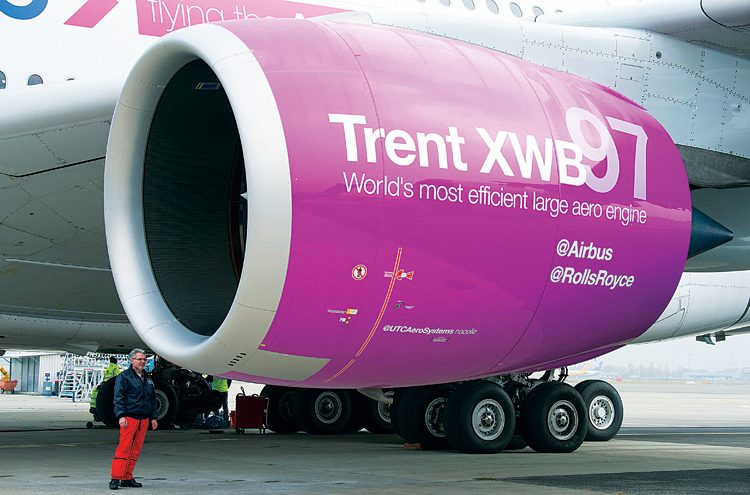Engine Innovations for Enhanced Performance and Fuel Burn
The Air Transport Action Group report indicates how fuel efficiency co-relates with the distance an aircraft can fly, the payload it can carry and, more importantly, offers better environmental performance

It is estimated that there are nearly 24,000 aircraft in commercial service in the world and that number is going to increase rapidly considering how air travel has become a convenient mode of transport for domestic and international travel. Planes fly faster, are quieter, larger and so comfortable that travelling has taken on a new experience. There have been continuous innovations and improvements that are transforming the aviation industry driven by environmental and operational mandates.
There have been significant technological advances in engines, which have led to lower fuel burn. The engine manufacturers continue to pursue research to further improve fuel efficiency and also explore alternative fuels to reduce carbon footprint.
CFM International has shown the way in innovation, bringing about 15 per cent fuel improvement on its LEAP engine, compared to its best CFM56 engines. The engines also have high level of dispatch reliability and good life-cycle maintenance costs. The LEAP engine is built for 99.98 per cent dispatch reliability which means more time in the air and less maintenance time. The LEAP engine’s fan blades are manufactured from 3D woven resin transfer molding carbon fiber composite, an industry first for CFM. This technology results in fan blades that are not only lightweight but also durable that each Individual blade is strong enough to support the weight of a wide-body airplane like the Airbus A350 or Boeing 787.
The Air Transport Action Group (ATAG) in its report has put out how fuel efficiency co-relates directly with the distance an aircraft can fly, the payload it can carry and, more importantly, offer environmental performance. For most of the twentieth century, aviation pioneers were obsessed with speed, first breaking the sound barrier and then pushing aircraft speeds higher and higher. It was the key to winning the air war and the key to exploring space. In the civil market, faster aircraft could fly higher above the worst of the weather and connect the world’s continents in ever decreasing times.
3D printed, lighter and stronger
The LEAP engine is the first engine to use additive manufacturing to ‘grow’ complex, fully dense yet lighter engines. Its fuel nozzles are 25 per cent lighter than previous models and five times more durable than parts manufactured conventionally.
Speed is not everything
It was only in the 1960s that it became clear that the cost of speed had to be measured in more than just dollars. Fast jets may have made intercontinental travel possible for a new generation of passengers, but they were also extremely noisy, especially for those communities living in the vicinity of airports. The aviation industry had to re-connect with the society it served and re-think its priorities.

The report states that in the 1980s and 1990s, aviation experts pushed the envelope of efficient aeronautical design to its limit. Faced with the challenge of delivering more power at lower noise levels, engine designers developed the extraordinary ‘high-bypass ratio’ engine which, since the 1970s, has delivered a quantum increase in power and a dramatic drop in noise levels. Thanks to the continued evolution of the high-bypass turbofan, aircraft are now 50 per cent quieter on an average today than they were ten years ago.
Aerospace engineers are constantly working on how to make planes more efficient. The report mentions how unlike ground vehicles, which don’t need to be optimised for efficiency to the same extent as aircraft because they can refuel often, long-distance aircraft must carry all their fuel with them. Fuel is expensive, heavy and takes up a great deal of storage space. Its weight can limit the range of an aircraft and it needs to be stored in tanks which affect the wing size and the payload.
Lower CO2 emissions
The aviation industry has come to measure its technical progress in the increasing efficiency of its aircraft and engines. Fuel is one of the highest cost items of an airline operation and oil prices are volatile. Therefore, when an airline decides to buy new aircraftt, fuel consumption is a primary consideration. There is also a direct link between reduced fuel use and environmental performance. Each tonne of fuel saved means approximately 3.15 tonnes fewer CO2 emissions, states the report. The most direct way for an airline to improve its fuel efficiency is to modernise its fleet with new aircraft incorporating the latest technology.
Historic trends in improving efficiency show that modern airliners are around 80 per cent more fuel efficient than those in the 1960s, ATAG states. These efficiency levels have been achieved with step changes in design such as the introduction of turbofan engines with increasingly high bypass ratios — coupled with year-on-year ‘incremental’ improvements to engine design and operation.
Turboprops, a step-change in power
Aircraft engines play the most important role in determining fuel efficiency. The arrival of the turboprop engine in the early 1940s was a step-change in power, reliability and efficiency over the piston engines then being used on regional aircraft. A turboprop engine is a gas turbine which powers a propeller. Pure turbojets enable aircraft to fly faster; but also use more fuel than a turboprop, making the turboprop a perfect engine for aircraft cruising between 480 and 650 kmph. A turbofanpowered jet aircraft flies at around 800 kmph.

In recent years there has been a resurgence of interest in the turboprop technology given their potential economic and environmental performance benefits, especially among regional aircraft developers. A modern turboprop can consume 25 to 40 per cent less fuel than an equivalent turbofan engine on short-haul routes.
High bypass ratio turbofan engines
ATAG states that the appearance of the high bypass ratio turbofan engine in the late 1960s, changed the civil aviation industry almost overnight. This new engine design was more than twice as powerful, but much quieter and cheaper to operate than the turbojets it replaced. It opened the door to a new generation of wide-body aircraft and a step change in engine efficiency which would see a gradual diminishing of aircraft noise footprint over the next 40 years.
THE RECENT TECHNOLOGY ADVANCES HAVE OPENED THE DOOR FOR THE FURTHER DEVELOPMENT OF TECHNOLOGY THAT HAS BEEN USED IN SMALLER AIRCRAFT ENGINES FOR SOME TIME – THE GEARED TURBOFAN
The ATAG report explains that the turbofan incorporates two changes in jet design. It adds a second low-pressure turbine and a large fan mounted in front of the compressor. The fan pulls in large amounts of air into the engine intake, some of which is directed into the hot core of the engine where it is compressed and then ignited; but most of which bypasses the core where it creates most of the engine’s thrust. If there is twice as much cold air bypassing the core as the hot air going through it, the bypass ratio is 2:1. The higher the bypass ratio, the better the fuel consumption as more thrust is being generated without burning more fuel. High bypass ratio turbofans are also much quieter than turbojets, in part because the flow of cold air surrounding the exhaust from the engine core reduces the noise produced by the exhaust gases.
The first commercial high bypass ratio turbofan engines had around a 5:1 bypass ratio. The latest models are around 11:1. It is also impressive that the latest model of engines for widebody aircraft generate over 1,15,000 pounds of thrust each — more than the thrust of four engines in the late 1960s, all while using less fuel, producing lower emissions and with a noise footprint just a fraction of that of the first jet aircraft, the report mentions.
More efficient engines by 2020
The ATAG report forecasts that a steady investment in advanced technology has enabled jet engine efficiency to improve at an average of one per cent a year. This means that engines available in 2020, are likely to be at least ten per cent more efficient than engines designed today. Engine manufacturers and government researchers are working so that this trend can continue over the next few decades.
The report states that recent technology advances have opened the door for the further development of technology that has been used in smaller aircraft engines for some time — the geared turbofan. A gear system (much like in a car) allows the fan section of a geared turbofan engine to operate at a lower speed and the low-pressure compressor and turbine to operate at much higher speeds thus increasing engine efficiency and lowering fuel consumption, gaseous emissions and noise levels. This new type of engine for narrow-body commercial aircraft, that entered service in 2013, provided 15 to 20 per cent improvement in efficiency over the engines they replaced. These engines have reduced noise footprints. New models of the geared turbofan should continue the historical efficiency improvement of one per cent per year or more.
So also, open-rotor engines which are gas turbines driving two high speed propellers moving in opposite directions are trending. The application of new aerodynamic and material technologies could see the return of the propeller-driven engine on larger aircraft, but with higher flight speeds and lower noise levels. This concept was first developed in the early 1980s, but was not pursued due to the relatively low fuel cost then Now with the intense interest in fuel economy and more advanced design techniques, the open-rotor design may have a renaissance. The report forecasts that by 2020, they could be ready for in-service use on some aircraft.





